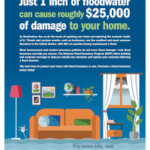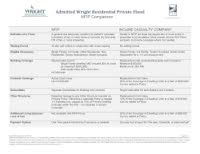Table of Contents[Hide][Show]
Floods are a serious concern for all Florida homeowners, no matter where they live. With the state’s flat terrain and frequent storms, it’s no surprise that floods are one of the most common natural disasters in the area. Unfortunately, most homeowners’ insurance policies do not cover flood damage. That’s why having a reliable Florida flood insurance policy is crucial to protect your property from costly repairs.
Whether you live in a high-risk flood zone or an area with a lower risk, flood insurance in Florida is more affordable than you might think, with options available from both the National Flood Insurance Program (NFIP) and private insurance companies. Protecting your home against flood damage is an investment in your peace of mind.
Why Every Florida Homeowner Should Consider Flood Insurance
Flooding in Florida can occur for various reasons: from hurricanes, tropical storms, and heavy rainfall to rising sea levels and storm surges. Florida’s low-lying areas are particularly vulnerable, but even properties in moderate- or low-risk zones are at risk. In fact, about 1 in 3 flood insurance claims come from areas that aren’t considered high-risk according to the National Flood Insurance Program’s Floodsmart website.
The cost of repairing flood damage can be devastating without the proper insurance in place. On average, just one inch of water can cause up to $25,000 in damage to your home. That’s why Florida flood insurance isn’t just for people who live near the coast—every Florida resident should consider a policy.
Understanding Florida Flood Insurance Coverage
Flood insurance is available through two main sources: the NFIP and private insurers. The NFIP is a government program that offers standardized policies, while private insurers can provide more customized solutions. Here’s a closer look at what each option offers:
1. National Flood Insurance Program (NFIP)
The NFIP is the most common option for flood insurance, offering coverage for both building structures and personal belongings. NFIP policies provide:
- Up to $250,000 in coverage for the structure of your home.
- Up to $100,000 in coverage for your personal property.
- Affordable rates, often starting around $400 to $700 annually for homes in low- to moderate-risk zones.
However, NFIP coverage does have its limitations. For example, it doesn’t cover certain areas of your property, such as basements or outdoor structures, and there’s a 30-day waiting period before the policy takes effect.
2. Private Flood Insurance Options
Private flood insurance is an alternative that provides more flexible and comprehensive coverage options than NFIP policies. With private flood insurance, you can customize your coverage limits and include protection for things like:
- Additional structures on your property (e.g., detached garages, sheds).
- Pool repair and deck coverage.
- Temporary living expenses if your home is uninhabitable after a flood.
Private flood insurance can be particularly beneficial for homeowners who need higher coverage limits than the NFIP’s $250,000 maximum or who own properties with a higher value. Private flood insurance policies often have shorter waiting periods than NFIP policies – often ranging from 7-10 days before coverage begins.
Excess Flood Insurance
Excess flood allows you to get additional coverage over the NFIP limits when you choose to go with an NFIP policy. There are some underwriting restrictions so it may not be available for every property, but this is a great option if you prefer to get an NFIP policy, but need additional coverage above the available NFIP limits.
Factors That Affect Florida Flood Insurance Rates
Several factors determine your Florida flood insurance premiums. Here are a few key considerations:
- Flood Zone: Homes in high-risk flood zones (Special Flood Hazard Areas, or SFHAs) tend to have higher premiums than those in low- or moderate-risk areas.
- Elevation: Homes built on higher ground or elevated above the base flood elevation (BFE) may qualify for lower premiums.
- Age of Home: Older homes, especially those built before modern floodplain management regulations, may face higher premiums.
- Home Structure: The design and materials used in building your home can affect your rate. Homes with basements, for example, may have higher premiums due to the increased flood risk.

Can Anything Help My Flood Rates? Any Flood Discounts?
Elevation Certificate
An elevation certificate can help Florida flood insurance rates significantly. While the flood zone is general for an area, and it does show individual properties, it doesn’t show the specific building info. Maybe the builder raised the foundation of your home. Maybe it’s on a natural hill that doesn’t show up on the flood maps. These are just some examples, but an elevation certificate will show the specific details of your home.
How high is the foundation? How high are the properties around it? If it’s a crawlspace foundation, what type of drainage features does it have? Etc. All of these types of factors will impact the risk for a specific property. Lower risk properties will get lower rates based on these factors. Without an elevation certificate, they are going to get the standard rates for the risk in the specific zone.
Elevation certificates may be on file with your city or county. This is especially likely if this is newer construction or if there has been significant modifications since its original construction. Some of the counties we’ve checked with started keeping these records between 1994 and 2004. If you want to new elevation certificate, a surveyor can usually provide one for you. Floods.org has some additional tips for getting elevation certificates.
Prior NFIP Flood Insurance
For people buying a house, if the seller had an NFIP policy in place, it can make a huge difference on your policy if you can get the policy details. We quoted a brand new policy for someone in Miami in a high risk zone, and it was about $5200 in a high-risk zone. However, they were able to get the seller’s policy details which they’d had for a long time. When we put in the prior policy info, the rate went down to about $940!
This may be due to several factors. The old policies required an elevation certificate, which as we discussed, that info can help the rating factors a lot. Also, on the Risk Rating 2.0 plan, there are some grandfathering of the rates, so it may have some grandfathered benefits on the property due to the previous policy.
Debunking Common Myths About Florida Flood Insurance
There are several misconceptions about Florida flood insurance that may prevent homeowners from getting the coverage they need. Let’s clear up some of the most common myths:
- “My homeowners’ insurance covers flooding.”
Unfortunately, most standard homeowners’ policies don’t cover flood damage. You’ll need a separate Florida flood insurance policy to be fully protected in most cases. - “I’m not in a flood zone, so I don’t need insurance.”
Flood zones are classified by the Federal Emergency Management Agency (FEMA), but they don’t guarantee safety. Floods can and do happen outside of high-risk zones, as 25% of flood claims come from these areas.- After Hurricane Ian hit, a friend posted on Facebook that they’ve lived in Florida for 4 decades, didn’t live in a flood zone, never had a direct hit from a hurricane, and never had flood insurance. Unfortunately, there was a retention pond behind their home that overflowed and several inches of water came into their home. You don’t realize how quick water can cause significant damage, as the drywall soaks up the water, cabinets soak up water, etc. After that experience, she wished that she had the flood coverage when she needed it.
- After Hurricane Debby, many homes in Bradenton and Sarasota were flooded in areas that were considered “not in a flood zone” (low risk zone). It is tragic what happened to these homeowners, and we don’t share it to celebrate their loss, but we want people to be aware of the possible risks, so we can avoid these situations in the future.
- “Florida flood insurance is too expensive.”
While costs vary depending on factors like your location and home elevation, flood insurance is more affordable than most people think, especially when compared to the potential cost of flood damage.
How to Get Flood Insurance in Florida

Getting flood insurance in Florida is a straightforward process. Simply give our team at Think Safe Insurance a call at 813-425-1626 or request a quote online. We can help with both NFIP and private flood options to make sure that you have the right coverage.
If you have an elevation certificate or if you are buying a home and the seller can provide a copy of their existing NFIP flood policy, that can help give you even better rates, but it isn’t required.
The Peace of Mind That Florida Flood Insurance Provides
Flooding is unpredictable, but with the right insurance policy, you can protect your home and belongings from financial disaster. Florida residents face unique risks due to the state’s climate and geography, but Florida flood insurance offers an affordable way to safeguard your home.
Get started today—contact us for a personalized Florida flood insurance quote and secure your home’s future against flood damage.



